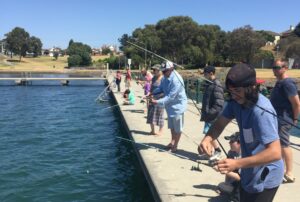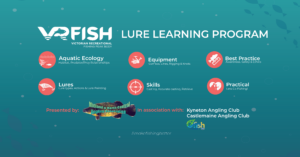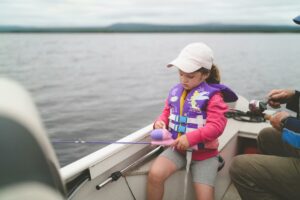July 24, 2017
By Bob Pearce, VRFish member and Albert Park Yachting and Angling Club.
“Don’t it always seem to go that you don’t know what you’ve got till it’s gone?” (Joni Mitchell – “Big Yellow Taxi,” 1970) – a fairly apt description of what has happened to our cherished Port Phillip Bay.
It would not, of course, be necessary to be re-building the Bay’s lost shellfish reefs if they had not been destroyed in the first place. Whilst there is now a general awareness of our project, it is probably fair to say less is known about what we once had but has been lost due to past over exploitation. This article will provide some background information about the problems we have inherited, how the project commenced and the new shellfish reefs that have been restored.
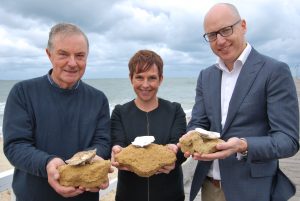
Minister for Agriculture, Jaala Pulford, with (left) Pat Hutchinson (Albert Park Yachting and Angling Club and (right) Rich Gilmore (The Nature Conservancy) at the announcement of the $147,000 Grant approval to expand the shellfish reef sites.
When you mention the word ‘oyster’ most people will immediately think about the oysters that you can purchase at the local supermarket or fresh fish outlet. These are mostly Pacific oysters, which are a species introduced into Australia and are endemic to Japan. It is a sad fact that the majority of people are not aware of the fact that we have a native oyster species that grow right here in our own Port Phillip Bay. Our native oysters have been known as ‘mud oysters’ or ‘flat oysters’ but have the scientific name of Ostrea Angasi.
Pacific oysters were first introduced into southeastern and western Australian waters for aquaculture in the 1940s and, as is often the case with introduced species, they have proven to be fairly hardy with the ability to out compete native shellfish.
By the 1980s they had found their way into New South Wales (NSW) waters, where they spread and invaded the intertidal habitats of many coastal waterways. There, they are generally regarded as a pest species and have caused significant problems for oyster farmers who culture native Sydney Rock oysters (Saccostrea glomerata). As the two species live and spawn in the same locations, Pacific oysters can settle on and smother farmed Sydney Rock oysters.
This article has not been written to demonise Pacific Oysters, but more to promote the profile of our own native species and the many benefits that will result if we can re-establish them in Port Phillip Bay, where they once existed in great numbers.
In so doing, a multitude of benefits will be achieved. Just as there was once a dense population of oyster reefs spread throughout the bay, so too there were beds of mussels and these mussel beds have also been depleted by over exploitation.
In the case of our native oysters, the over exploitation seems to have originated in the 19th Century due to an oyster dredge fishery in the bay, where oyster shells were harvested for both consumption and lime production. In fact, it is probable that by the late 1800s, flat oyster fisheries in Victoria and other states were largely fished out. The heavy fishing pressure by oyster dredgers in colonial times lead to the first Fisheries Bill to protect oyster populations. But it seemed to have been a case of too little, too late.
Also, in the 1960s a dredge fishery for scallops commenced and after a number of years of excessive exploitation, scallop beds became seriously depleted. In northern Port Phillip Bay, dredging activities then turned to shallow water shellfish reefs which were still fairly intact until the early 1980s. Around this time, I recall witnessing some of the carnage that occurred, where I saw some very large boats fill hundreds of sacks with mussels and oysters. They did this on a regular basis, but no-one seemed to care much at the time, even though this destructive fishing method would ultimately decimate marine habitat in a way that it has never been able to recover. Eventually, dredge fishing was banned and there has been some recovery of scallop beds, but the damage to oyster and mussel reefs was so severe they have not been able to re-establish themselves naturally.
In my case, I was fortunate to have been born in Albert Park and lived right on Beaconsfield Parade, just across the road from the beach and, from an early age, developed an affinity with the beach, the salt water and all of the things that went with it. Mussels were extremely prolific and easy to access from the local jetties. After a storm, millions of mussels and oysters were washed off the (then prolific) reefs, so a feed of fresh oysters was easily collected from the shallow water.
Albert Park Yachting and Angling Club (APYAC) was established in 1909, so there is a lot of knowledge within the Club of what we once had in northern Port Phillip Bay, but has been lost. APYAC has a strong history of supporting the local community, so when we had a discussion about the lost shellfish reefs at one of our Club meeting nights, it was hardly surprising that a decision was taken to approach Fisheries Victoria to see if there was some way that we could work together to do something about the problem.
It was pleasing to receive a prompt positive response and, thanks to the personal support for the project from Fisheries Victoria’s Senior Manager, Anthony Forster, the project was able to get off to a great start. It should not be overlooked that, this was the first project of its type in Australia and we have led the way for other states to follow.
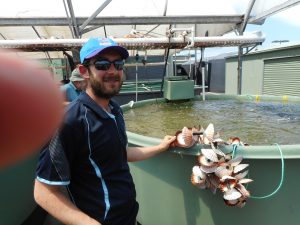
Victorian Shellfish Hatchery Manager, Michael Shipley, showing
scallop shells to which oyster spat will attach while in the tank
A lot of what has happened to get us to where we are with the project is now water under the bridge, but there have been a number of developments and milestones reached along the way, some examples being:
- We have been fortunate to have the initial and ongoing support from both Anthony Forster and Dr Paul Hamer (PIR Vic), without whom, we might not have progressed as far as we have with the project.
- The ability of the Victorian Shellfish Hatchery in Queenscliff, to produce oyster spat, without which we would not have been able to initiate the project.
- The involvement of The Nature Conservancy (TNC) in the project. TNC is a truly great organisation which has supported the project in terms of technical know-how, the services of highly skilled staff and a substantial financial contribution to the project ($200,000 plus significant “in Kind” contribution).
- A substantial government financial contribution from The Recreational Fishing Initiative funds ($120,000).
- APYAC’s successful funding application to the Recreational Fishing Licence Trust Account ($147,000). This successful grant application was announced by the Minister for Agriculture, Jaala Pulford, on the 12th February.
- A direct financial contribution to the project by APYAC ($40,000 so far).
- Support for the project from some aquaculture farmers.
- Quite a lot of support in terms of volunteer labour from APYAC members and the general community through the Restore The Bay Network.
- Support from restaurants and seafood wholesalers as part of the Shell Recycling Project whereby cured shells are being used as reef substrate and in the hatchery process.
- Greatly appreciated support from VRFish throughout the course of the project. The project is being managed by the Foundation Partners being, Fisheries Victoria, TNC and Albert Park Yachting and Angling Club. The University of Melbourne is also playing a vital role with the project.
Currently, the project has moved into the Stage 2 scale-up phase, which has been possible because of the above mentioned $147,000 grant from the Recreational Fishing Licence Trust Account and the $50,000 contribution from TNC, as well as in-kind project coordination and monitoring.

Delivering limestone to the site off St Kilda in early April, 2017.
The current phase of the project involves the deployment of 360 tonnes of limestone at Margaret’s Reef, off St Kilda in Hobson’s Bay, and at Wilsons Spit near Geelong, covering over 600 square meters in total across both reefs. The limestone will provide the foundation for over 300,000 juvenile native Angasi oyster hatchlings that divers will spread evenly over the limestone.
Gabion elevation units have also been deployed surrounding the new reefs to further test oyster growth and survival and help create natural recruitment hotspots. This part of the project is being led by The University of Melbourne.
In placing native oysters and mussels on the two sites, it is just like building a block of apartments for a myriad of marine creatures and, thereby, achieving a massive increase in marine bio diversity.
Since the commencement of the project, a variety of fish and various other forms of marine life have quickly been attracted to these areas and this is expected to increase significantly, ultimately including the beloved snapper.
Additionally, we can expect to see improved water quality in the Bay as shellfish numbers increase. Shellfish are filter feeders and are, therefore, the Bay’s natural cleaners. A single oyster can filter hundreds of litres per day. Just imagine what hundreds of thousands of them will do. Eventually, there will be millions of them, as over time, it is expected that the oysters and mussels being deployed will reach maturity and begin to recruit naturally.
As success is being seen to be achieved with this project, it is logical to expect that it will be expanded at the current two sites. It is also logical to expect that further sites will be found within the Bay for the commencement of similar projects.
As we start to positively demonstrate the project’s success with key deliverables such as increased marine biodiversity, cleaner water and more fish, the future will look very bright for our beloved Port Phillip Bay.
This article appeared in the Winter 2017 edition of VRFish’s Fishing Lines Magazine.





